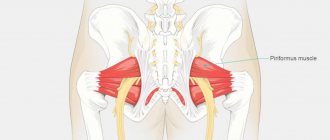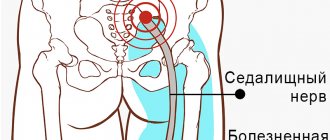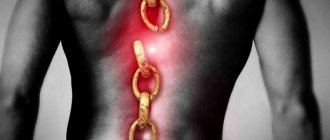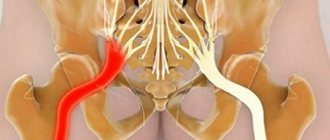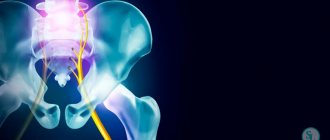What is a pinched sciatic nerve?
The sciatic nerves start from the lower back, then go through the tailbone, pelvis and legs and end at the foot. When a pinched sciatic nerve is diagnosed, the most common concern is severe pain, cutting or stabbing. Pinching occurs on one side, but sometimes bilateral damage is diagnosed. If you do not see a doctor in time, the condition may worsen. In addition to pinching, there is also inflammation of the same nerve, which manifests itself with the same symptoms. Another name for this disease is “sciatica.”
Diagnostics
Diagnosis begins with a medical history and physical examination by a physician. The doctor needs to find out the symptoms, what causes changes in the pain syndrome (load, body position). In addition, a history of trauma and concomitant pathology (for example, arthritis) is important. The doctor will then check your posture, gait, and location of pain. Sensitivity and reflex activity will be checked because sometimes it is difficult to differentiate pain coming from the iliosacral joint from pain of vertebral origin. If an infection or joint disease is suspected, laboratory tests of blood and urine may be prescribed.
X-ray – allows you to determine the degree of degenerative changes in the iliosacral joints and in the spine.
MRI allows more detailed visualization of morphological changes in the pelvis and spine. There is also a special research method called neurography, which allows you to visualize the nerves. This becomes possible with special programs on MRI computers and allows you to see areas of irritation along the nerve.
Radioisotope scanning is necessary in cases of suspected infectious or oncological disease. The most reliable way to diagnose piriformis muscle syndrome is a diagnostic injection of an anesthetic into the muscle. The introduction is best done under X-ray or X-ray control. The disappearance of pain after injection of local anesthetic into the muscle confirms the diagnosis of piriformis muscle syndrome.
Causes
Pinched sciatic nerve is caused by the following reasons:
- Intervertebral hernia. This is the main cause of the disease. Intervertebral spacers fall out, which in a healthy person prevent the vertebrae from collapsing.
- Osteochondrosis. Metabolic processes in bone tissue are disrupted, causing them to grow and affect the spinal nerves.
- Spinal injury.
- Constant hard physical labor.
- Hypothermia, especially of the back.
Causes of lumbago
Most often, pain in the lower back occurs against the background of osteochondrosis, herniated formations of intervertebral discs and spondyloarthrosis. It can also be the result of severe overstrain of the ligaments and muscles of the back. In approximately 30% of patients, the etiology of lumbago remains unclear, despite comprehensive diagnostics.
The following causes of the disease are identified:
- awkward sudden movements;
- spinal injuries;
- sudden rise in weight;
- staying in an uncomfortable position for a long time;
- hypothermia, especially with previous overheating of the body.
In addition, the causes that lead to the development of degenerative-dystrophic changes in the spine and the formation of intervertebral hernias are involved in the appearance of lumbago. An improper sedentary lifestyle or, conversely, excessive stress on the spine (professional sports, areas of activity associated with physical labor) plays a big role. Also etiological factors are: obesity, poor diet low in vitamins and microelements, some endocrine and metabolic disorders in the body.
Intervertebral disc damage
Mostly lumbago manifests itself in the initial stage of the degenerative process in the intervertebral disc. The latter loses its elasticity and structure. Its nucleus pulposus is deformed, “spreading” to the sides or moving to the side, most often back or back and to the side.
With movement and physical stress, the nucleus pulposus shifts even further, putting pressure on the annulus fibrosus of the disc, which contains sensory receptors. Irritation of peripheral sensory nerve endings causes a response impulse in the structures of the brain, which is manifested by pain, tonic tension of the lower back muscles and reflex reactions.
Vertebral displacement
Symptoms of lumbago can be caused by spondylolisthesis (slipping of an individual vertebra relative to the underlying one). More often, pathology occurs after an accident, an unsuccessful fall, prolonged exposure to an unphysiological position, or after sudden lifting of weights.
Displacement of the vertebral body outside the normal axis of the spine leads to pinching of the nerve trunks and the appearance of severe pain. In most cases, spondylolisthesis is detected at the level of L5-S1, less often - L3-L4. According to various authors, pathology occurs in 2-6% of the population.
Congenital vertebral anomalies
Qualitative and quantitative defects of the lumbar spine often manifest as pain. During sacralization (fusion of the sacrum and the fifth lumbar vertebra), lumbarization (separation of the first sacral vertebra from the sacrum) or fusion of several lumbar vertebrae, compression of the spinal roots may occur. Compression of nerve fibers causes severe pain.
When the shape changes, non-fusion of the vertebral bodies and arches, intervertebral hernias and other pathologies of the spinal column often develop. As a result, painful sensations of varying severity and disturbances in the motor and sensory spheres appear.
Rare causes of lumbago
Very rarely, lumbago occurs against the background of rheumatic diseases, some infectious diseases and tumor processes. In this case, the fibrous ring of the intervertebral disc itself or the ligaments adjacent to it may be affected.
Neoplasms can compress (benign tumors) or grow (malignant tumors) bone, cartilage, muscle and connective tissue structures. The pain is of a pronounced chronic nature. It may not stop for several months or even years.
Symptoms
Is this really a pinched sciatic nerve, symptoms and treatment can only be determined by a neurologist
. It is this specialist that you should contact if the following symptoms appear:
- pain, for some it is not severe, for others it is quite intense, it bothers you on one side, it intensifies when sitting;
- burning and tingling in the lower part of the leg;
- when walking, the leg hurts, there is a feeling of petrification;
- the pain becomes more intense when coughing, laughing, if a person stands for a long time or sits on something hard;
- Sweating of the feet may increase, the skin turns red, and swelling occurs.
If you have a pinched sciatic nerve, the symptoms vary, depending on how severely the nerve is affected. In especially severe cases, this disease may cause the leg muscles and gluteal muscles to shrink, and it becomes difficult to move the toes or turn the foot.
Internal funds
How else to cure sciatica with folk remedies? Nature took care of the person even in the event of this illness.
There are medicinal plants for oral administration that help relieve the inflammatory process in the tissues of the lower back, and therefore eliminate severe pain.
True, plants will not help as quickly as chemical medications, but they are very helpful when, for example, pharmaceutical chemicals are contraindicated for a number of reasons (allergy, intolerance, etc.).
In addition, they are excellent auxiliary means that, in combination with other therapy, quickly help get rid of this disease.
To begin treating sciatica with folk remedies, in particular by taking medicinal herbs, they must first be properly prepared. Each type has its own method and dosage.
Recipe No. 1:
- Purchase horse chestnut seeds.
- Further them in the amount of 2 tsp. should be brewed with 0.5 liters of boiling water in a glass container.
- Afterwards the container is placed in a water bath for about 10-15 minutes.
- At the end, the resulting product must be cooled and filtered.
- It is taken 100 ml before meals several times a day until relief is felt.
Recipe No. 2:
- Dried calendula flowers in a dosage of 2 tbsp. l. brew with 2 cups of boiling water.
- All this is infused in a tightly closed glass container for several hours.
- Afterwards the product is filtered.
- You need to consume it 0.5 cups before meals 3-4 times every 24 hours.
Recipe No. 3:
- Dry, pre-crushed root in the amount of 1 tbsp. l. pour 1 glass of red wine, better if it is Cahors.
- Next, heat the mixture over low heat for approximately 5 minutes. At the same time, it is not brought to a boil.
- Afterwards it is filtered.
- The resulting portion of the product is divided into 2 doses. The first part is taken before breakfast, the second - before dinner. For each new day, a fresh decoction is prepared.
Thus, now many have learned how to treat sciatica with folk remedies. But since each human body is individual, if you decide to use them, you must first consult with a doctor.
After all, even seemingly harmless medicinal herbs can cause serious health problems for someone. That is, folk methods also need to be approached with caution.
Alexandra Bonina recommends a simple exercise for pinching the sciatic nerve.
Denial of responsibility
The information in the articles is for general information purposes only and should not be used for self-diagnosis of health problems or for therapeutic purposes. This article is not a substitute for medical advice from a doctor (neurologist, therapist). Please consult your doctor first to know the exact cause of your health problem.
How to treat a pinched sciatic nerve?
How to treat a pinched sciatic nerve? Treatment should be selected by a doctor after a detailed examination. You should not resort to self-medication - you can only worsen the situation. Let's talk about the main methods of treating a pinched sciatic nerve.
Massage
Massage for this disease is contraindicated, otherwise the patient’s condition may worsen. However, if the doctor recommended this procedure, you should not refuse. He or she may refer you to a specialist who specializes in these conditions. However, you should not do a massage yourself, especially before you go to a specialist.
Exercises
Exercise can help with recovery. However, if you have an acute pinched sciatic nerve, it is better to avoid them. Exercises should be performed only during the period of remission. Activities help when the load is evenly distributed on both legs, i.e. race walking or running, swimming, skiing. However, excessive loads are harmful, so running should only be light; skiing should be done leisurely. There are also special exercises, but only the attending physician should select such a complex of physical therapy. Exercise helps improve blood circulation in the legs and strengthens the muscles.
Drug treatment
If you have a pinched sciatic nerve, treatment includes taking various medications that should reduce the pain. When the disease worsens, pain-relieving injections are prescribed, which can be given intravenously, intramuscularly or into the epidural space. Local agents that improve blood circulation and relieve pain and swelling can also be used. To relax spasmodic muscles, vitamins B1 and B6 are prescribed.
Painkillers
How to cure a pinched sciatic nerve? Most often, the patient is prescribed painkillers, NSAIDs. These can be either over-the-counter medications (Aspirin, Ibuprofen, Ketoprofen) or prescription medications (Naproxan). However, it is necessary to take these medications correctly. Drinking them with food will reduce the likelihood of stomach discomfort. Otherwise, there is a high risk of developing an ulcer. Therefore, all medications must be prescribed by a specialist, strictly selecting dosages. He will also tell you how to take these medications correctly to reduce side effects.
Spa treatment
If you do not have an exacerbation, your doctor may recommend spa treatment, i.e. courses of underwater traction, mud therapy, pearl or hydrogen sulfide baths. This will not only help cope with the disease, but also strengthen the immune system, and also allow the patient to rest and recover, which is also necessary for recovery.
Yoga
Yoga can help cope with illness. Specially selected poses help relax muscles, reduce pain, and improve blood circulation. However, during periods of exacerbation, it is better to avoid yoga. Remember to warm up first, do a warm-up, and only then perform more complex exercises. It is advisable to talk with professionals who will help you choose the right set of asanas.
Electrophoresis
Doctors note that physiotherapeutic methods of treatment, including electrophoresis, have proven themselves well. It reduces pain, helps warm the affected area, removes swelling, and improves blood circulation.
Folk remedies
If you want to cure this disease at home using traditional methods, remember that they are unreliable, i.e. there is no guarantee that you will get better. However, if you feel that folk remedies help you, you can use them, provided that they are safe. A honey cake will help cope with the pain. To prepare it, you need to heat 1 tbsp in a water bath. l. honey and mix it with 1 tbsp. l. flour, make a flat cake. Place this flatbread on the sore spot, wrap it in cellophane and then with a warm scarf.
Treatment of inflammation of the sciatic nerve with folk remedies.
- The most effective and fastest folk remedy for treating the sciatic nerve is dry heat on the painful area.
- Another available folk method for treating sciatica is a radish compress. Grate the black radish on a coarse grater, place it on a waterproof mat, cover the radish with 2-3 layers of gauze and lie on the compress with your sore back for 30-40 minutes.
- Salo with pepper is a simple homemade way to quickly cure sciatica. Grind hot peppers in a meat grinder. Mix with the same volume of pork fat and grind well. Rub this mixture into the skin of the lower back 2 times a day.
- Traditional medicine recommends a clay cake for the treatment of sciatica. You need to knead the dough from rye flour or clay, make a flat cake and bandage it to the sore spot until the morning.
- Treatment of sciatica with saline solution. If the sciatic nerve is inflamed, rub your body with salt water 2 times a week: 2 tablespoons of sea salt per 1 liter of water.
All these measures will help in the rapid treatment of the sciatic nerve. The speed of recovery depends on the patient’s persistence. Source: newspaper “Bulletin of Healthy Lifestyle” 2013, No. 19 pp. 12-13 .
Prevention
How to prevent the occurrence of such a serious disease? There are several rules that everyone who cares about their health must follow:
- Don't overload yourself. Physical activity should be moderate.
- If you work in an office, at a computer, organize your workspace correctly, make sure that the chair is not too low or soft.
- Sleep on a hard surface or buy an orthopedic mattress.
- Regularly do exercises that strengthen your back muscles, and walk more.
- Try not to get too cold.
A pinched sciatic nerve is a serious condition that is difficult to treat. As soon as the first symptoms appear, it is better to consult a doctor. Painkillers, physiotherapy, spa treatment, etc. will help cope with the disease. However, it is still better to prevent it by following simple rules.
How to suspect the onset of sciatica
It is necessary to understand that it is quite difficult to cure the sciatic nerve, so the sooner attention was paid to the pathological condition, the greater the chances of success. The following specific conditions must be taken into account:. Uncomfortable feeling that occurs during prolonged sitting or standing static position.
Uncomfortable feeling that occurs during prolonged sitting or standing static position.
When suddenly a sharp pain pierces the lower back or leg.
When the range of movement of the legs becomes limited.
We advise you to study - Exercises for chondrosis: a complex of effective gymnastics at home
As soon as any of the symptoms makes itself felt, this is the most serious reason to take care of your own health and contact the appropriate specialist. He will be able to make an accurate diagnosis and prescribe adequate treatment that will be able to eliminate the problem or at least stop it.
Sciatica – drug treatment
Non-steroidal anti-inflammatory drugs are used in the treatment of sciatica. These medications provide a stable therapeutic effect:
- elimination of inflammation;
- removal of swelling;
- short-term or long-term pain relief.
Medical treatment of the sciatic nerve includes the use of steroidal anti-inflammatory drugs. They are chosen even when non-steroidal drugs do not provide the desired effect. The dosage form of the drugs can be any: suppository, capsule, tablet. Depending on the patient’s overall tolerance to a particular medicinal substance, a course of treatment is selected that will provide maximum effect.
Ointment for sciatica
It is mainly used in the lumbar region. Ointment for sciatica is good for pain relief and inflammation because it acts locally and does not have negative effects on other organs of the body. There are a sufficient number of ointments that treat and alleviate the symptoms of sciatica. They are divided according to their mode of action:
- local non-steroidal anti-inflammatory drugs;
- chondroprotectors (used for osteochondrosis);
- homeopathic ointments (call on the body to actively counteract the disease);
- distracting and irritating drugs;
- combination drugs.
Injections for sciatica
Steroidal anti-inflammatory medications are used for this purpose. Injections for sciatica are prescribed if the disease has taken an acute form. Their advantage is that they are effective, do not cause much harm to the body, and have few side effects. Treatment with injections minimizes the risk of intoxication or poisoning of the body. This medicine acts much faster than others at the site of inflammation. Sciatica - the symptoms and treatment of this disease should only be determined by a doctor based on all examinations.
Painkillers for sciatica
Painful attacks due to sciatica can be very severe and constantly disturb (the pain makes it impossible to sleep). All tablets must be prescribed by a doctor after conducting appropriate examinations. Only he can prescribe the correct medication, dosage, and duration of treatment. Painkillers for sciatica due to pinching or inflammation of the sciatic nerve are very important; their task is to block prostaglandins (substances responsible for pain). There are many such painkillers and they have different active ingredients. The most famous of them:
- Ibuprofen;
- Analgin;
- Ketoprofen;
- Diclofenac;
- Piroxicam et al.
Exercises for sciatica
Exercises are effective in treating sciatica, but absolute caution must be used in movements. Therapeutic exercises for sciatica are useful, effective and prevent blood stagnation.
There are several types of therapeutic exercises, including standing and lying exercises. To perform them, no special training or readiness for intense physical activity is required:
- Exercises while lying down. Performed by bending the legs at the knees. You need to lie on your back, pulling your knees as close to your chest as possible, while you need to clasp your buttocks with your hands and hold the position for about 30 seconds.
- Exercises while sitting. In a sitting position on the floor, you need to stretch your legs forward, while smoothly placing your hands behind your back, connecting your shoulder blades. Repeat up to 5 times.
- Exercise while standing. Standing on the floor, you need to put your feet shoulder-width apart, and then raise one hand up and lower the other down. Raising your arms one by one, you need to bend in different directions.
Symptoms and treatment of sciatica at home with folk remedies.
But sometimes the pain is so strong that even the slightest movement becomes akin to torture: it is impossible to lift something, it is impossible to straighten up, the pain, like lightning, pierces at the slightest movement, it hurts even just to lie down.
Sometimes the sensitivity of the skin is impaired or a burning sensation of the skin appears along the sciatic nerve (manifests either in the left leg or in the right), and reflexes are impaired.
Doctors easily diagnose it as sciatica. We will look at how to treat sciatica at home in this article. Of course, you need to undergo an examination, but pain from sciatica - pinching of the sciatic nerve - cannot be confused with something else.
Official medicine, on the one hand, can quickly get a person back on his feet, but on the other hand, painkillers have a lot of side effects and contraindications. Treatment of sciatica with folk remedies at home in this case may be a better solution.
Methods for diagnosing sciatica
Doctors first refer the patient for an x-ray. This diagnostic method will help detect sciatica immediately. However, it must be remembered that radiography is prohibited during pregnancy, severe obesity and psychological anxiety of the patient.
Computed tomography can be used for diagnosis. The study will show the exact causes of sciatica and make a three-dimensional model of the lumbar region indicating the pain zone. During pregnancy, this type of examination is also prohibited.
Doctors often prescribe magnetic resonance imaging examinations. The procedure will show precise images of the tissues, spinal column and discs. It will be possible to see three-dimensional images of the spinal cord and understand the extent of the damage. MRI will help to see the condition of the vessels, roots and nearby tissues.
In rare cases, diagnosis by electroneuromyography is prescribed. The procedure will help to see nerve conduction and show the patient's sensitivity at the moment of movement. Special electrodes will be placed on the muscles, which will mark the passage of impulses along the nerves.
Traditional medicine as a way to combat sciatica
Time-tested folk recipes have proven themselves very well and give a quick and guaranteed effect. But still, treatment of sciatica at home should be carried out as an addition to other methods of therapy. There are a whole variety of traditional medicine suitable for the treatment of sciatica, including decoctions, infusions, compresses and rubs, and ointments.
Decoctions and infusions for the treatment of sciatica
- mix thyme, calendula, viburnum color (1.5 tablespoons each), horsetail (3 tablespoons). 2 tbsp. spoons of herbal mixture pour 0.5 l. boiling water, boil for 2 minutes, turn off, let cool and take 0.5 cups 3 times a day before meals;
- Brew beans and beans as tea and drink;
- aspen leaves (1 tablespoon), add water (1 liter) and boil. Drink before meals, 4 rubles/day, 250 g;
- calendula roots (1 tbsp.) and water (250 g.) Calendula infusion is often used, boil for 5 minutes, strain and drink 125 g. 2 rubles/day.
Compresses for the treatment of sciatica
- rub the problem area, apply hot beeswax and wrap the area;
- grate horseradish root and potatoes in a ratio of 1.1, mix, add a spoonful of honey. Place the mixture in a cloth and apply it to the sore spot. You definitely need to wrap yourself up.
- cabbage leaves are applied to problem areas and insulated with woolen cloth.
- propolis and beeswax are mixed in a 1:1 ratio, after which they are applied to the affected area for several hours;
- Mix egg white with 20 ml of turpentine, apply to the sore area every five hours and hold until a strong burning sensation appears.
Rubs for the treatment of sciatica
Therapy using rubbing is done by the following means:
- fir oil;
- badger fat;
- alcohol tincture on birch buds;
- agave leaves;
- St. John's wort tincture.
Ointments for the treatment of sciatica
- Mix ground iris root (3 tablespoons) with vegetable oil (1 cup). Rub into the sore spot 2 times a day.
- Vodka (250 gr.), black radish juice (5 glasses), 1 glass of honey, salt (1 tablespoon). Stir and refrigerate. Shake before use.
Baths for the treatment of sciatica
- steam pine shoots (1 kg) with water (3 liters), strain and pour into the bath in a ratio of 1:15. Take no more than 10 minutes, water temperature no more than 37°.
- add angelica decoction to the water;
- make a paste of mustard powder (400 g) with water and add to the bath. The water should be cool.
We advise you to study - Spinal traction at home
There are many folk recipes for treating the disease; the main thing is not to let the disease take its course.
Massage at home
To treat this ailment at home, you can also do acupressure, which will help the spinal tissues recover more easily. Massage can be done only when the inflammation has passed. It needs to be done in three stages:
- Determine the most painful point.
- Massage this point and the point behind the hip joint on the buttock.
- Sedative massage of the meridian points of the bladder.
New pain should not appear during the massage. If discomfort is felt, then this method should be stopped.
Gymnastics at home for the treatment of sciatica
Gymnastics is an effective method of treating inflammation of the sciatic nerve. There is no need to do complex and time-consuming exercises. The main thing to remember is that you should start doing gymnastics only after the acute stage of the disease has ended - the exercises should not cause you discomfort. Here are some exercises (all done while lying on your back on a hard surface):
- pull your legs to your chest and grab your buttocks, lower your legs to the starting position. Repeat 10 times.
- with your knees bent, try to pull your legs towards you, return to the starting position. Repeat 10 times.
- lie on your stomach, lift your body as if doing push-ups, without using your hands. Repeat 5 times.
Do exercises without fanaticism! It is advisable that your attending physician knows about your treatment methods and approves them. Your main priority is your well-being and health!
https://youtube.com/watch?v=2oesyhMg2PI
